![]()
English 3186/CompLit 3605
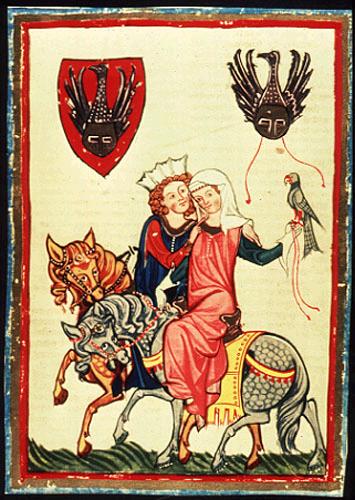
Hawking: see Erec and
Enide
Required Texts:
Online:
Longus, Daphnis and Chloe;
Ovid, The Art of Love
http://www.poetryintranslation.com/PITBR/Latin/Artoflovehome.htm
Marie de France. Lais. http://www.clas.ufl.edu/users/jshoaf/Marie/
Texts:
Chretien de Troyes. Arthurian Romances., Penguin..
Gottfried von Strassburg. Tristan. Trans. Hatto. Penguin.
Dante, Inferno, Canto V (link online)
Emily Bronte. Wuthering Heights. Norton.
Dashiell Hammett. The Maltese Falcon. Vintage, 1992.
Jose Saramago. Baltasar and Blimunda. Harcourt.1982.
Course Requirements:
1. Students are expected to have read
all the material due at each class meeting.
2. There will be frequent quizzes, reader response papers, and
one-page textual analyses.
3. There will be two 3-page papers (worth 10%, 15% respectively, due on
a rotating group schedule) and a 5-7 page final research paper (35%).
4. You may hand in one paper late (but no more than one
week late). Otherwise, no late papers will be accepted.
5. There wil be a midterm (15%)
6. Students are allowed three absences. Two latenesses = one absence.
7. Failure to complete all assignments on time and/or excessive absence
will result in a lowered grade for the course.
8. Students who plagiarize may receive an F for the course.
Grades will be computed as follows:
15% participation, quizzes, discussion leader
10% 4 one-page response papers---due any time before a work is discussed in class
10 % 3-page paper
15% online writing project
15 % midterm
35% final paper (5% proposal, outline; 5% annotated bibliography: 5%; presentation; paper: 20%)Paper groups:
Group 1: Cao, Clinton, Kundrat, Mekonen, Rolon, Zhen, Wharton, Atieh, Ellams, McClain, Defreitas
Group 2: Demming, Heath, Rodriguez, Cleary, Davies, Lugo, Reyes, Vanible, Agababaeva, Croweak
For Wed., Aug 30:Read Daphnis and Chloe, Books 1 and 2 (online link)
Look at syllabus and select date to serve as discussion leader
For Wednesday, Sept. 6:
Read Daphnis and Chloe, Books 3 and 4.
Ravel, Daphnis and Chloe, suite 2: https://www.youtube.com/watch?v=amGl9Qmgu7E
Chagall, Daphnis and Chloe images

Knighting Ceremony
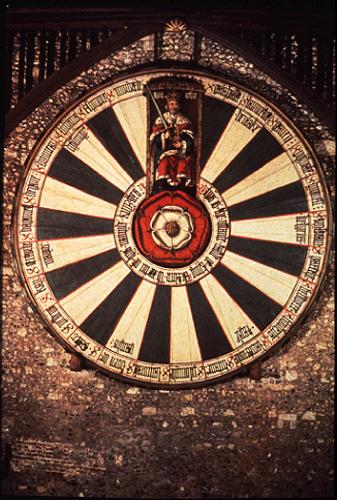
Slides: King Arthur's Table, Winchester Cathedral. 18' in diameter, weighing 1 1/2tons.
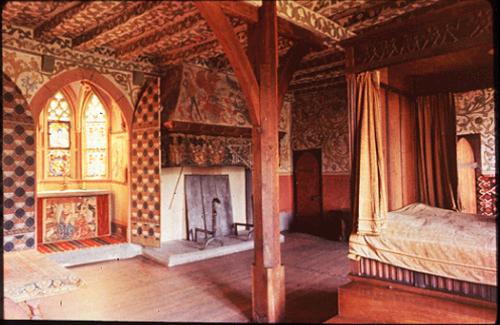
Medieval bedroom

Pavillions and tournaments
For Monday, Sept 11:
Read Ovid, The Art of Love http://www.poetryintranslation.com/PITBR/Latin/Artoflovehome.htm
Book I, Parts 1-3, 9-11, 16; Book III, Parts 1-3, 7, 9, 12-14,
18
See the following study guide for explanations of many of the
allusions:
https://brians.wsu.edu/2016/10/17/ovid-the-art-of-love/
Discussion
leader: Jensine
.

Wednesday, Sept 13:
Read Europe in 1050 (handout); read the
Introduction to Arthurian Romances
Discussion leader: Adam
Monday, Sept 18:
Read Yvain, through line 3999. Be prepared to discuss
StudyGuide, questions 1-5.
Discussion leader:Val
For animal symbolism, check the following link:http://bestiary.ca/index.html
Yvain
 Lunete gives Yvain the
ring
Lunete gives Yvain the
ring
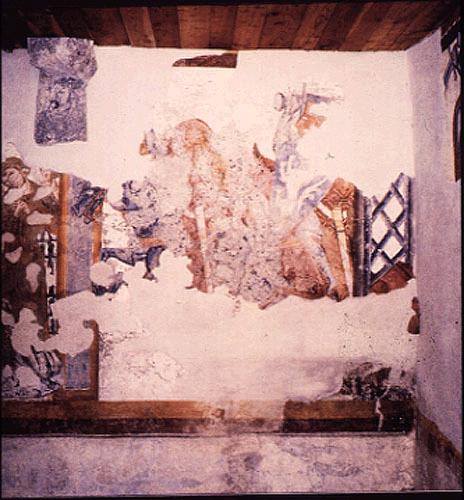
Yvain at the portcullis
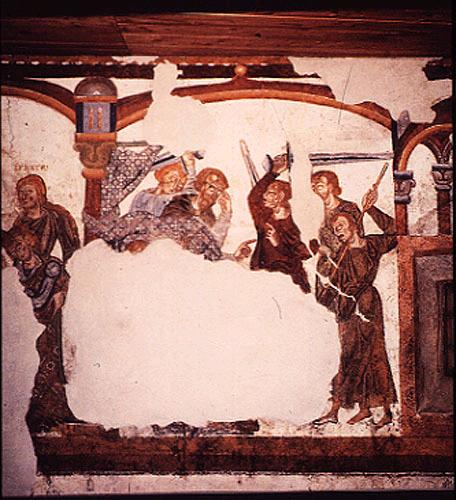
Searching for Yvain
For Mon., Sept. 25: Finish Yvain. Be prepared to discuss all
Study Guide questions.
Discussion leader: Jasmine
Study Guide for Yvain:
Motifs: magic; loyalty;
1.What
two forces motivate Yvain?
2. How does Chretien describe Love?
3.
Describe the strengths and weaknesses of the female characters.
4.
Describe Lunete. What is her most positive characteristic?
5. How does
Lunete persuade her mistress to accept Yvain?
6. Discuss the magical
elements of the Yvain romance.
Paper 1--- Group 1 (10% of final grade) Due Monday, Oct. 2
3 pages, 12-point font, 1" margins
Know your audience: DO NOT SUMMARIZE THE PLOT; be sure to use relevant
quotes to support your argument; proofread carefully.
Choose ONE of the following topics:
1. In what ways does the Lion serve as a counterpart toYvain?
2. Negative and positive images of women in Yvain.
3. Apply Ovid's Art of Love to
Yvain.
4. Discuss the theme of disguise in Yvain.
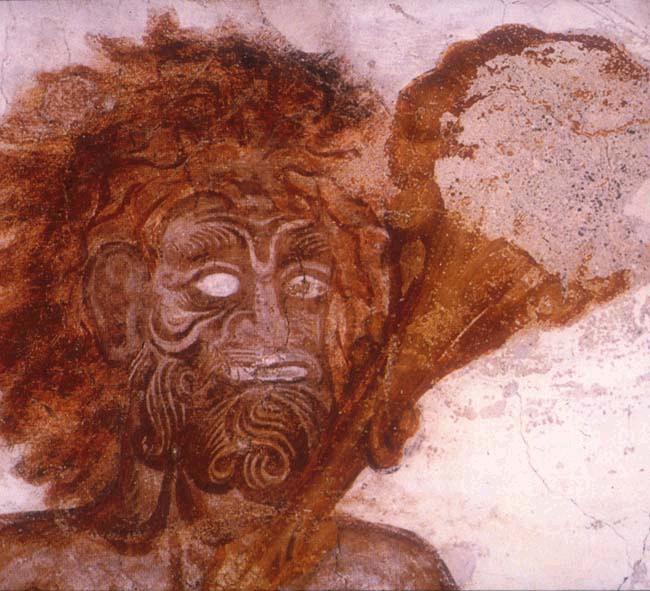
Churl

Yvain at the stone
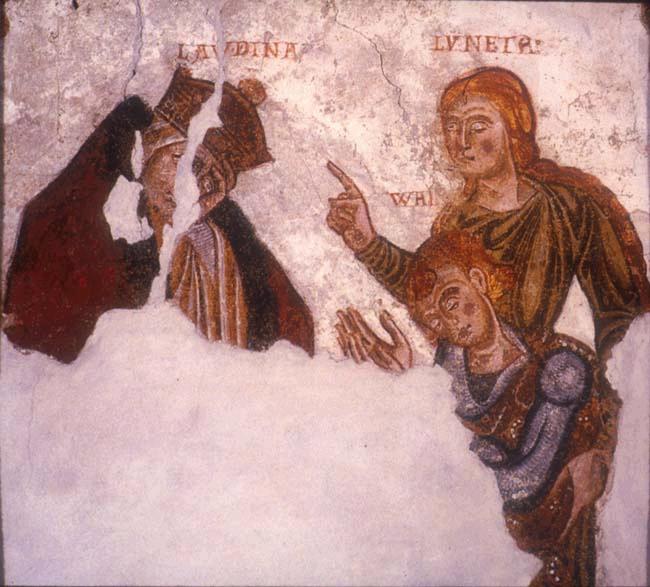
Yvain, Lunete and Laudine
Wed, Sept 27: Marie de France : Discussion
leader: Devon
Bisclavret and Yonec (online)http://www.clas.ufl.edu/users/jshoaf/Marie/
 manuscript
from Yonec
manuscript
from Yonec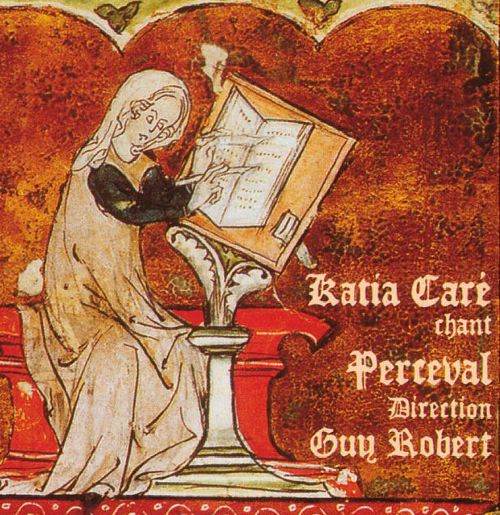
Study Guide:
1. Contrast the wife's rejection of her husband for his beastliness
with the king's admiration of the same creature for his humanity.
2. Can you compare the insatiably curious wife with any
Biblical figure?
3. Why is tearing off the wife's nose considered a particularly terrible
punishment?
4. What lessons might this tale
convey to its female readers?
Yonec
1. What reflections of Ovid can you note in the lady's curses?
2. What possible role is attributed to literature in this lai?
3. Why does the lady make the hawk-like knight say that he believes in
God?
4. What does this story say about how beauty is maintained in women?
5. According to the lover, what has betrayed their secret?
6. How does religion function in this lay? How does it relate to love?
Paper 1, Group 2: Due Wednesday, Oct. 11
3 pages, 12-point font, 1" margins. CHOOSE ONE OF
THE FOLLOWING TOPICS
Know your audience: DO NOT SUMMARIZE THE PLOT; be sure to use relevant
quotes to support your argument; proofread carefully.
1. Contrast the themes and structures of Bisclavret and Yonec.
2. In what way does a central symbol unify both lais?
3. The medieval world of Marie de France---What features of the world
of her characters does she emphasize and why?
4. Compare one of the heroines from Yvain with a heroine in the
lais of Marie de France
5. "Silence is golden," or maybe not. The effects of silence in Lanval.
For Monday, Oct 2:
1. Go to the website and read Lanval and Chevrefoil;
Discussion leader: Edmund
http://www.english.ufl.edu/exemplaria/intro.html
You might want to start reading Tristan. We will begin
discussing the text on Wednesday, Mar. 9
Read Chapters 1, 6, 8-29, 30,
34-40.
Study Guide for Marie de France
Lanval
1. What is the treatment of love in Lanval?
2.
Does this lai represent conventional, Church-sanctioned morality? If not,
what values does it represent.
3. What is the one dish” that Lanval has in abundance?
4. How are Guenevere and Arthur portrayed?
5. What
are their shortcomings?
6. Who or what is Lanval's sweetheart?
7.
Are you surprised by the ending? Is it justified?
8. What are the
implications for the target audience? Is there a more serious message
here?
Chevrefoil
1. Note the references to writing.
2. What
is the attitude towards adultery?
3. With whom does Marie appear to
feel sympathy?
4. What attitude seems to be expected of the
audience?
5. Explain the symbolism of the hazel and the
honeysuckle.
October 4, 11,16:
Tristan and Isolde
For Wednesday, Oct 4: READ CHAPTERS 1-5.
Discussion leader: Natasha
Study Guide: Tristan and Isolde
Images: http://www.lib.rochester.edu/camelot/trismenu.htm#images
Identify the following locations:
Brittany (Bretagne):
Cornwall:
Tintagel:
Parmenie:
How did the people in England become interested in Breton tales?
Identify the following characters and their significance to the plot:
Rivalin:
Morgan:
King Mark of Cornwall:
Blancheflor:
Rual
li Foitenant:
Tristan:
Curvenal:
Morold:
King Gurman of
Ireland:
Queen Isolde:
Isolde:
Tantris:
Brangane:
The
Steward:
Images of the nature of love:
Explain how these images describe
the love of Tristan and Isolde. Do they relate to any of Chretien’s
romances?
Bird and the lime-twig (p. 52-54; 196):
Bridled vs.
unbridles (tamed vs. untames fancy):
Ardent:
Love as a tyrant
(54):
Isolde as a siren (148):
Anchorless ship and an lodestone
(148):
Love the Ensnarer (52-3; 198; 202):
Love the Dyer
(198):
Antithesis (love as a pleasing illness) (195-204):
Instead of paper 2, all
students will contribute to an online discussion board through Blackboard
for 3 out of 4 possible times during the semester. You can access our
discussion board through English 3186 (both for those registered through
complit and those registered through English).
Each student will
post one (at least) 250-word response to one of the topics online, and
will also respond to two other students' postings (in at least 150
words). You will receive a possible maximum of 5 points for participating
in each of the three online writing tasks: 1 point each for your responses
to your classsmates' postings; 0-3 points for your own 250-word response.
The maximum credit for the 3 postings is 15 points. There is
presently a discussion thread with topics on Tristan. This thread closes
on October 18 at 11:59PM. There will be three more opportunities to
participate, with topics on Wuthering Heights, Maltese Falcon, and
Balthasar and Blimunda. Try to plan your participation around both your
available time and your interests.
This exercise replaces paper 2
for both writing groups.
POST 1 for both writing groups----on blackboard
Themes:
1. The theme of Tristan's education and the evolution of his skills. Discuss three instances of Tristan's talents as a means of advancing the plot. Does Tristan possess skills that are different from the other romance heroes we have discussed?
2. How is Isolde's beauty described in the test? What recurring images appear? (look at 185-186).
3. Think about the differences between the love between Tristan and Isolde and the other love relationships we have read about this semester. How is Gottfried's view of love different from Chretien's?
4. Compare the portrait of Isolde to the portrait of women in Chretien.
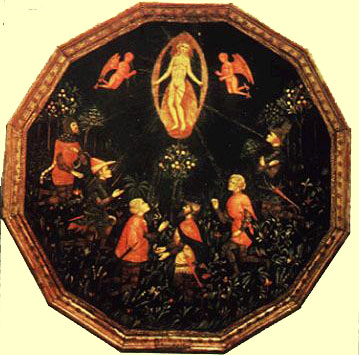
Tristan and Lancelot

Tristan and the Dragon
For Wed., Oct. 11:
Discussion leader: .Dan
Study Guide for Tristan and Isolde, Part 2
Read Chapters 6-29
1. Identify the following and describe their relevance to
the story:
The splinter
Dragon's tongue
Tribute to Ireland
2.
How does the character Morolt function in the plot? What connections to
other characters are established through him?
3. How does the reader
know that Tristan is not yet in love with Isolde?
4. What evidence is there of Isolde's shift of feeling towards Tristan?
5. Explain the following images of love. Are they reminiscent of images
in the other romances we have read this semester?
Love the dyer (198)
Love the
physician (201-2)
6. How are both Isolde's and Tristan's beauty described?
For Mon., Oct. 16: Read chapters 39-40; Discussion
leader:
Identify:
Gandin
Marjodoc
Melot
Duke Gilan of Swales
Petitcreiu
Urgan li Vilus
Olive twig
Carleon
Trial by ordeal
How do the following episodes function in the narrative of
the story?
Brangane's substitution for Isolde on the wedding night
Gandin's taking Isolde; Tristan's rescuing Isolde
Isolde's convincing Mark that his suspicions are unfounded
Flour trap
The
lepers
Possession of Petitcreiu
The Cave of Lovers (261-266)
allegorical interpretations:
Describe the cave and try to relate each
physical part to another, symbolic meaning
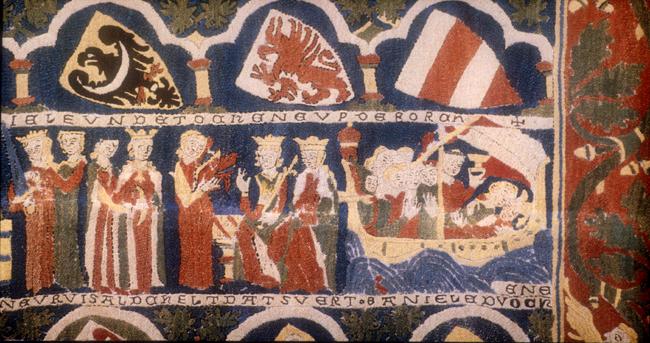
Tristan and Isolde Drink the Potion
Read Dante, Inferno, Canto 5 (Paolo and Francesca) Cut and paste the link . Print out the canto and bring the hard copy to class on Wednesday.
https://digitaldante.columbia.edu/dante/divine-comedy/inferno/inferno-5/
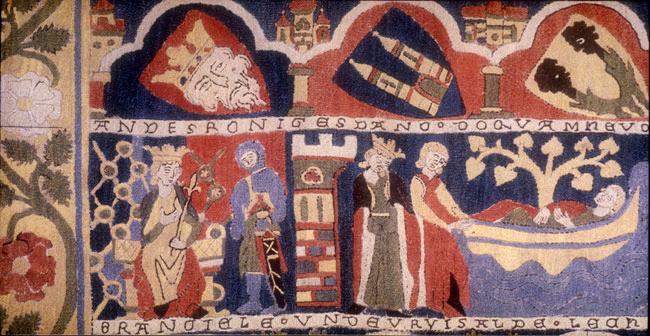
Wed., Oct. 25: Wuthering Heights; BE SURE YOU HAVE THE EDITION
WE ARE USING (Norton)
Read through Chapter XII
Discussion leader: Nicco
In class discussion - Wuthering Heights Study Guide
1. What is Nelly's relationship to Catherine? Is she an ally or an enemy?
Look carefully at the scene in which Catherine confides her plan to marry
Edgar.
2. Identify all the love relationships in the novel. What motivates each
relationship or what attracts one person to another?
3. List all the crucial events that Nelly influences. What are Nelly's
motives?
For Mon., Oct. 30: Read through Chapter 18
Discussion leader: Tonisha
4. Examine Catherine's first and second illnesses (Chapters 11-12; Chapter
14).
When she becomes dangerously ill, what time in her life does her mind
turn to?
5. Chapter 15: Heathcliff and Catherine's last meeting.
6. What is Heathcliff's reaction to Catherine's death?
7. What type of child is Linton? How much of his father does he have?
8. . Why is Cathy vulnerable to Linton's appeals?
For Wed., Nov. 1: Read Chap 18-28
Discussion leader: Teresa
For Mon. Nov. 6: finish Wuthering Heights;
Discussion leader: Jorge
One-page summary of or response to one of the critical essays or one
of the historical documents from the Norton edition; DUE Wed, Nov. 8
Norton essays: or one of the following (available online)
Philip K. Wion, The Absent Mother in Wuthering Heights
Terry Eagleton, Myths of Power: A Marxist Study of Wuthering Heights
Nancy Armstrong, Imperialist Nostalgia and Wuthering Heights
Lyn Pykett, Changing the Names: The Two Catherines
Susan Meyer, From "Your Father Was Emperor of China, and Your Mother
an Indian Queen": Reverse Imperialism in Wuthering Heights.
Discussion questions in class:
1. Look at Chapters 33-34. What change has come over Heathcliff? How can
you account for that change?
2. What do you think is the purpose of having two narrators--- Lockwood
and Nelly----in the structure of the narrative?
3. How do WH and Thrushcross Grange differ as physical places? Are there
any similarities between them? What do these similarities and differences
suggest about the symbolism attached to them in the novel?
4. Discuss the parallels between the first and second generation characters
at Wuthering Heights and Thrushcross Grange, the Earnshaw-Linton-Heathcliff
characters.
5. This is an excerpt from a review of Wuthering Heights which
appeared in Douglas Jerrold's Weekly Newspaper, dated January 14, 1848:
In Wuthering Heights the reader is shocked, disgusted, almost
sickened by details of cruelty, inhumanity, and the most diabolical hate
and vengeance, and anon comes passages of powerful testimony to the supreme
power of love---even over demons in the human form. The women in the book
are of a strange fiendish-angelic nature, tantalizing, and terrible, and
the men are indescribable out of the book itself."
Do you agree or disagree (or both) with the reviewer's analysis? Why?
6. Some critics consider Catherine a female version of the romantic quest figure, searching to overcome a divided soul. Do you consider Catherine a divided soul, conflicted within herself? What are Catherine's divisions and conflicts? What destructive choices does Catherine make? What constructive choices?
7. How does Bronte try to unify the three generations represented in Wuthering Heights? How does the love relationship of Cathy and Hareton mirror the relationship between Catherine and Heathcliff? How does the daughter resemble the mother? How are Hareton and Heathcliff alike? And how is the younger generation different from their ancestors?
8. Is Nelly a better friend to Heathcliff or to Catherine?
9. Identify the following quotes. What do they reveal
about the characters?
a. "He shall never know how I love him: and that, not because he's
handsome, but because he's more myself than I am. Whatever our souls are
made of, his and mine are the same."
b. "Mr Heathcliff forms a singular contrast to his abode and style
of living. He is a dark-skinned gypsy in aspect, in dress and manners
a gentleman"
c. "Terror made me cruel; and, finding it useless to attempt shaking
the creature off, I pulled its wrist on the broken pane, and rubbed it
to and fro till the blood ran down and soaked the bedclothes."
d. "He's but a boy---but he scowls so plainly in his face; would
it not be a kindness to the country to hang him at once, before he shows
his nature in acts as well as teatures?"
e. "I've dreamt in my life dreams that have stayed with me ever after,
and changed my ideas; they've gone through and through me, like wine through
water, and altered the colour of my mind."
f. "I have no pity! I have no pity! The more the worms writhe, the
more I yearn to crush their entrails! It's a moral teething; and I grind
with greater energy, in proportion to the increse of pain"
g. "She has no lover or liker among us---and she does not deserve
one. She';ll snap at the master himself, and as good as dares him to thrash
her; and the more hurt she gets, the more venomous she grows."
h. "I have lost the faculty of enjoying their destruction, and I
am too idle to destroy for nothing.
POST 2 DUE Friday, Nov 10
CHOOSE ONE OF
THE FOLLOWING TOPICS; respond to TWO of your classmates' posts:
Know your audience: DO NOT SUMMARIZE THE PLOT; be sure to use relevant
quotes to support your argument; proofread carefully.
(5% of final grade): Choose one of the following topics, or e-mail me
if you have another idea you'd like to write about. Be sure to
use quotes and specific references from the text to support your ideas.
1. Discuss the significance of dreams in Wuthering Heights. What
do they reveal about characters? Can you find this dream motif in other
romances we read this semester. How do dreams particularly fit the genre
of romance?
2. Discuss the natural images in Wuthering Heights. How can nature
be considered as the mirror of man's soul? How does this depiction fit
the romance genre?
3. The theme of the supernatural in Wuthering Heights. In
what way is this theme romantic?
4. The role of books, or learning, in Wuthering Heights.
Wed., Nov 8- Mon., Nov. 13: Maltese Falcon;
Discussion leader: 11/13, Justine
Wed: (Chapters 1-10)
Monday: (chapters 10-end); Discussion leader: Keana
POST 3:
Due Wednesday, Nov 15 by midnight
CHOOSE ONE OF
THE FOLLOWING TOPICS; respond to two of your classmates' posts:
Know your audience: DO NOT SUMMARIZE THE PLOT; be sure to use relevant
quotes to support your argument; proofread carefully.
1. The detective as a modern knight errant.
2. Responsibility to society as a theme in romance
3. Isolation --- how is the detective's relationship to society different
from that of the medieval knight hero's relationship to his feudal society?
Wed., Nov. 15: Baltasar and Blimunda
Read through p. 47
Discussion leader: Kimberly
Extra credit: The Cloisters
Copy and paste this link for the schedule of free
guided talks at the Cloisters: http://www.metmuseum.org/events/programs/met-tours/gallery-talks-cloisters
If you cannot get to one of these talks (which you would then summarize
from your notes in 2-3 pages), do a self-guided tour with this topic in
mind:
Examine the different representations of lions: on frescoes, on
sarcophagi, on tapestries. Discuss how the lion is depicted, and how the
physical portrayal of the lion matches or differs from the lions you've
read about in medieval romances this semester. 2-3 pages. Due Wednesday,
Nov. 29
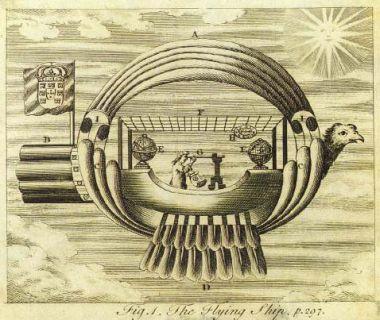 Passarola
Passarola
Baltasar and Blimunda
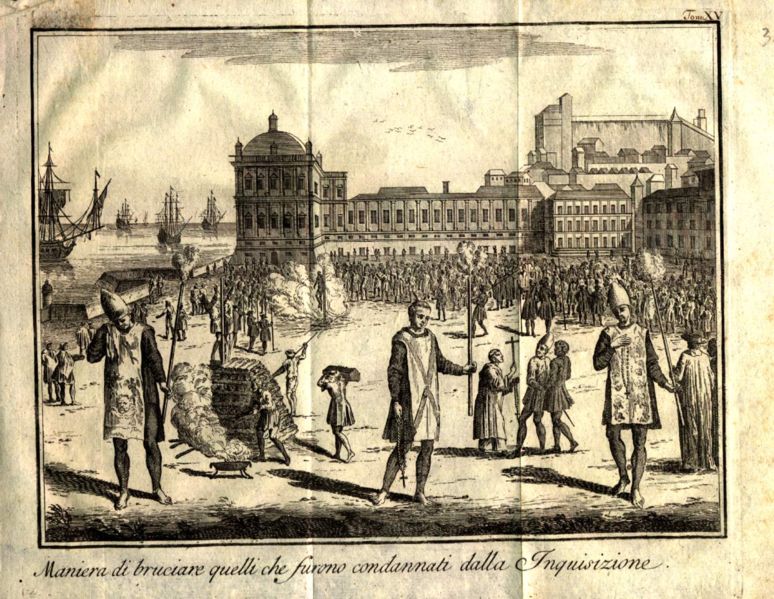
Anonymous engraver from the 17th century, "Way to burn those who
were condemned by the Inquisition". Autodafé and stakes
of the Portuguese Inquisition, from a 17th century original engraving.
Personal scan. This engraving shows the Praça do Comércio
of Lisbon (at the time called the Palace Square) before the 1755 earthquake.
The building in the image is the Ribeira Palace, later destroyed by
the quake.
.jpg)
Saint Dominic Presides Over an Auto da Fe, Pedro Berruquete,
Prado Museum
For Wednesday, Nov 22: . Read through p. 223
Discussion leader: Asiaa
Monday, Nov. 27: Finish Baltasar and Blimunda.
Discussion leader: Rafael
Post 4: Baltasar and Blimunda:
FOR WEDNESDAY, Nov. 29 Final paper topic--to discuss in class
Review
of the semester's readings.
Sample Annotated Bibliographies:
Annotated Bibliography
Ignatieff, Michael. "What Did the C.I.A. Do to Eric Olson's Father?"
The New York Times
Magazine 1 Apr. 2001. Web. 3 Dec. 2014.
Ignatieff discusses the mysterious death of Frank Olson who worked at
Camp Detrick for
the CIA in the early 50s and was an unwitting MKUltra test subject, dosed
with LSD
by his CIA supervisor. He died by falling out a window of a New York hotel
room nine
days later. It was passed off as a suicide, but an ongoing investigation
by Olson's son,
thanks to the declassification of MKUltra documents via a 1977 Freedom
of Information
Act request, has made it more apparent that it was most likely murder.
Lemov, Rebecca. "Brainwashing's Avatar: The Curious Career Of Dr.
Ewen Cameron."
Grey Room 45 (2011): 61-87. Academic Search Complete. Web. 3 Dec. 2014.
A look at the unethical human experiments of Project MKUltra under Dr.
Donald Ewen
Cameron's administration at Allan Memorial Institute in Canada. Patients
would be
dosed with LSD and other drugs, receive intense electroconvulsive therapy,
often
rendering patients comatose for long periods of time. Interestingly enough,
it seems
Cameron was motivated not necessarily, or at least not entirely, by power
but a desire to
rid people of their neuroses and mental illnesses, whereas the CIA was
concerned with
gaining control and perfecting brainwashing techniques to aid in interrogations
and
Cameron wanted to erase people's memories to create a blank slate, so
to speak.
Marks, John. The Search for the "Manchurian Candidate": The
CIA and Mind Control. New
York: Times, 1979. Print.
Based on interviews and 15,000 pages of CIA documents declassified under
the Freedom
of Information Act, Marks provides a comprehensive and thorough description
of CIA
activities from the Cold War period, obviously including Project MKUltra.
Punkcast. "Hank Albarelli - A Terrible Mistake." Online video
clip. Youtube. Youtube, 22 May
2002. Web. 3 Dec. 2014.
In this book reading, Albarelli gives a brief overview of his book detailing
the Frank
Olson case more thoroughly. There's also a Q&A period, further clarifying
CIA activities
from this time period.
Annotated Bibliography:
Birken, Lawrence. "Madame Bovary and the Dissolution of Bourgeois
Sexuality." Journal of the History of Sexuality 2.4 (1992):
609-620. JSTOR. Web. 5 December 2012.
Birken writes about Emma's desires for a man and that the qualities she
seeks are the same that one would require of a woman, child or immature
person. The three are seemingly synonymous. This reflects women in Parisian
society. Women do not work and are dressed up and taken care of by their
husbands, much like a child. Therefore, one can understand why children
in 19th century France are often described and treated romantically, on
a pedestal for their fathers just as a wife. Perhaps, because women and
children are so similar, Emma Bovary is such a poor parent because she
is also poor to herself. She is much like a child and puts herself in
situations that are potentially heartbreaking. We know she has a poor
opinion of herself because she wishes her child was a boy because men
can do anything they want to while women have a multitude of limitations
weighing on them.
Culler, Jonathan. "The Uses of Madame Bovary." Diacritics
11.3 (1981): 74-81. JSTOR. Web. 5 December 2012.
In this article, Emma is characterized as "a foolish woman in narrow
circumstances." Her motivation is sex. In order to assist Emma in
finding her own femininity, she accepts marriage and motherhood. These
are the ways in which she attempts to liberate herself. The article is
based around Freud who writes, "If the wish for a penis is replaced
by the wish for a baby, that is, a baby takes the place of a penis . .
. Her happiness is great if later on this wish for a baby finds fulfillment
in reality -quite especially so if the baby is a little boy who brings
the longed-for penis with him." The book supplements this article
where Emma says "this idea of having a male child was like an expected
revenge for all her impotence in the past." This "penis-envy"
is deeply rooted in Emma and she was looking for a child not for the sake
of motherhood but with the desire to mold him and complete herself.
Golata, John. "'Pere Goriot' and 'King Lear.'" The English
Journal 56.9 (1967): 1288-1289. JSTOR. Web. 5 December 2012.
Through comparing the royal King Lear with the notorious and famous Pere
Goriot, one can examine how even noble characters are subject to the same
petty mistakes as the common citizen. King Lear and Pere Goriot manifest
their demise in different ways, all stemming from an uncontrollable amount
of love for their children. King Lear's strong love for his daughter causes
him to be overly wary and critical of her while Pere Goriot's intense
passion blinds him such that he cannot recognize that they are ingrates.
Delphine and Anastasie's devotion had only been to a hypocritical Parisian
society. Two key points are noted in this article. One includes mention
of the scene at the funeral of Goriot's daughters' carriages riding through
the procession, empty. This parallels the daughters themselves, consumed
with keeping up appearances but devoid of character and compassion underneath.
The other point speaks to the role of a parent and how complex it is.
Being a parent is without precise definitions and how to be a good one
has no immediate answer.
Savage, Catharine H. "The Romantic 'Pere Goriot.'" Studies
in Romanticism 5.2 (1966): 104-112. JSTOR. Web. 5 December 2012.
The focus of this article is to highlight the conservative bourgeois lifestyle
predicated on materialism and self-image; the driving forces behind the
patricide ultimately committed by Anastasie and Delphine. Their behavior
is a direct criticism of society which Eugene seeks to manipulate and
disassociate himself from. Like society, the children lack orderliness
and virtue and romance are what propels them to their father. The daughters
exhibit extreme vanity thus dispelling their filial duty and as a result
never function in a "daughterly" way throughout the book. Coupled
with the daughters' disdain for one another, the entire family is dysfunctional.
There are parallels between the way the daughters degrade themselves to
supplement their husbands and the way Pere Goriot depreciates his fortune
for his children. The romantic role and fatherly one mesh.
.
Link for Mel Brooks' Spanish Inquisition number from History of
the World Part 1: http://www.youtube.com/watch?v=oppHeMlaLVM
Wednesday, Nov 29 (by email): Annotated bibliography for final paper
For pictures and history of the convent at Mafra, click here:
http://en.wikipedia.org/wiki/Mafra_National_Palace
Research presentations: Wednesday, Dec. 6; Monday, Dec. 11.
Final Presentation schedule:
Wed., Dec. 6:
Monday, Dec. 11:
Final paper proposal: Due Wednesday, Nov. 29:
You must submit a one-page proposal with:
A clear, limited topic for your paper, stating the question that you will
explore and the argument you will make.
A list of at least 3 secondary sources (some of these can come from the
Norton critical editions we have been using). This should be in MLA format
and ANNOTATED (for each source, write 2-3 sentences that justify its use
for your particular topic).
A list at least 3 passages from the primary text that you will analyze
closely in your paper as support for your argument. You will not merely
summarize the passages, but rather subject them to a close, detailed reading
that yields evidence to support your argument. submit your paper topic,
secondary sources, and relevant passages
Have this information available online so that you can project it to the class. E-mail the proposal and bibliography to me by Monday, May 9 (no matter which day you are presenting).
Final paper (35% of final grade---5% outline, proposal; 5% annotated
bibliography; 5% presentation; 20% paper): Due Monday, Dec. 18: NO LATE
PAPERS ACCEPTED.
If you e-mail your paper, it must be sent before midnight on Dec. 18; if
you leave it in my mailbox, it must be received by 3PM.
Final Paper Topics:
1. Discuss the significance of dreams in Wuthering Heights. What
do they reveal about characters? Can you find this dream motif in other
romances we read this semester. How do dreams particularly fit the genre
of romance?
2. Discuss the natural images in Wuthering Heights or Baltasar
and Blimunda. How can nature be considered as the mirror of man's
soul? How does this depiction fit the romance genre?
3. The theme of the supernatural in either Wuthering Heights or
Baltasar and Blimunda. In what way is this theme romantic?
4. How can Sam Spade be seen as a new type of romantic hero?
5. Analyze the romantic elements of Baltasar and Blimunda.
6. The motif of music in Tristan or Baltasar. How does
music function in one of these two romances?
7. Windows and doors in Wuthering Heights.
8. Magic in two
of the romances we read this semester. How does magic propel the plot?
How does it reflect the values of the times?
9. The evolving romantic
hero: do a close analysis of the change in the attributes of the romance
hero from the medieval texts (Yvain, Tristan)to the modern texts (WH,
Maltese Falcon, Baltasar and Blimunda). Choose one medieval and
one modern text.
10. Use a particuar critical lens to analyze one of
the following: WH; Baltasar and Blimunda; Yvain; the lais of Marie de
France; Maltese Falcon; Tristan and Isolde. This could be, for
example, through a feminist lens, a Marxist lens.
11. Quests:
compare the quest theme in one medieval and one modern romance. What
links these two quests as romance? How has the theme of quest evolved
from medieval to modern times?
12. Romance as social criticism.
Choose one work that we've read this semester and explain how its themes
offer a criticism of its contemporary society.
************************************************************************************************************************
************************************************************************************************************************
************************************************************************************************************************
Read Erec and Enide Part I (in Arthurian Legends, through
line 3516)
Study Guide: Erec and Enide
Be prepared to discuss the following motifs:
Enide's dress
Enide's silence
Enide and Erec riding togethe
1. What inspires the knight?
2. What is the role of the dwarf?
3. What is the hunt for the white stag? How does it influence the action
of the romance?
4. Describe, based on the text, life at court. Be sure to support your
descriptions with specific references to the text (page numbers)
a. the population
b. mobility of the court.
c. entertainment.
d. hierarchy
5. What was the proper behavior towards the vanquished?
6. What other legendary figures are referred to in Erec and Enide?
7. What is the image of family love? marital love?
8. What were the obligaitons of a knight?
9. What were the duties of the king?
10. What is the relationship between the lord and his knights?
11. What rewards could a lord offer?
Part II: For Wednesday, Sept 13: Finish Erec and Enide
discussion leader:
12. What can you infer from the descriptions of food and feasts?
13. What can you infer about court life from the descriptions of clothing?s
14. What can you infer about the relations between the court and other
lands? Why?
15. When does the author ask the audience to suspend their disbelief?
16. In what ways does love for Enide inspire Erec?
17. Give examples of Enide's courtesy; of Erec's.
18. What role does the Church play in the life of the court?
aper 1, Group 1 (10% of final grade): 3 pages, 12-point font, 1"
margins, due Monday, Sept 18 : CHOOSE ONE OF THE FOLLOWING
TOPICS
Know your audience: DO NOT SUMMARIZE THE PLOT; be sure to use relevant
quotes to support your argument; proofread carefully.
1. Respond to the feminist criticism that considers the message of this
romance to be that "The only proper role for woman according to
this romance is silent submission" (Lynn Tarte Ramey, Representations
of Women in Chretien's Erec and Enide").
2. What do the festive ceremonies reveal about the court society?
3. How does magic shape this romance?
4. Discuss the animal symbolism in this romance.
Read: Daphnis and Chloe, Books 1 and 2, p. 3-44.
http://www.uvm.edu/~classics/slides/a61.jpeg
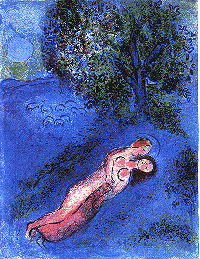 Chagall
Chagall
For more of Chagall's illustrations of Daphnis and Chloe, see http://www.weinstein.com/chagall/images.html#DandChloe
Read Wordsworth's Ode: Intimations of Immortality http://www.bartleby.com/101/536.html
And listen to Canned Heat's http://www.youtube.com/watch?v=Hf0Dm-OaTNk
For Wed. Feb. 9: Read Daphnis and Chloe, Books 3 and 4.
Response paper: One page. Choose one of the following topics:
Young love and old love; city vs. country; this love story as a reflection
of the values of society?; role of the gods in the romance; theme of the
apple; symmetry..
Panflute: http://www.panflutejedi.com/syrinximage.html
Listen to these excerpts from Ravel's Daphnis and Chloe, Suite 2:
sunrise
http://www.youtube.com/watch?v=mrOJcEHXYWM&feature=related
flute solo
http://www.youtube.com/watch?v=2HdpAoI8Ciw&NR=1
Dionysian theme:
http://www.youtube.com/watch?v=HC5z1cvkdds&NR=1